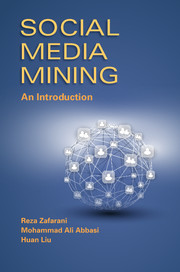2 - Graph Essentials
from Part I - Essentials
Published online by Cambridge University Press: 05 July 2014
Summary
We live in a connected world in which networks are intertwined with our daily life. Networks of air and land transportation help us reach our destinations; critical infrastructure networks that distribute water and electricity are essential for our society and economy to function; and networks of communication help disseminate information at an unprecedented rate. Finally, our social interactions form social networks of friends, family, and colleagues. Social media attests to the growing body of these social networks in which individuals interact with one another through friendships, email, blogposts, buying similar products, and many other mechanisms.
Social media mining aims to make sense of these individuals embedded in networks. These connected networks can be conveniently represented using graphs. As an example, consider a set of individuals on a social networking site where we want to find the most influential individual. Each individual can be represented using a node (circle) and two individuals who know each other can be connected with an edge (line). In Figure 2.1, we showa set of seven individuals and their friendships. Consider a hypothetical social theory that states that “the more individuals you know, the more influential you are.” This theory in our graph translates to the individual with the maximum degree (the number of edges connected to its corresponding node) being the most influential person. Therefore, in this network Juan is the most influential individual because he knows four others, which is more than anyone else. This simple scenario is an instance of many problems that arise in social media, which can be solved by modeling the problem as a graph.
Information
- Type
- Chapter
- Information
- Social Media MiningAn Introduction, pp. 13 - 50Publisher: Cambridge University PressPrint publication year: 2014
